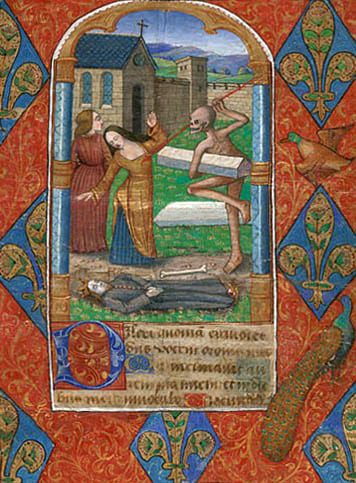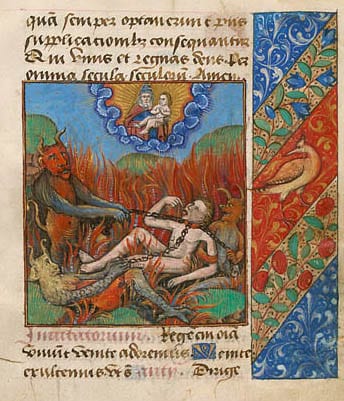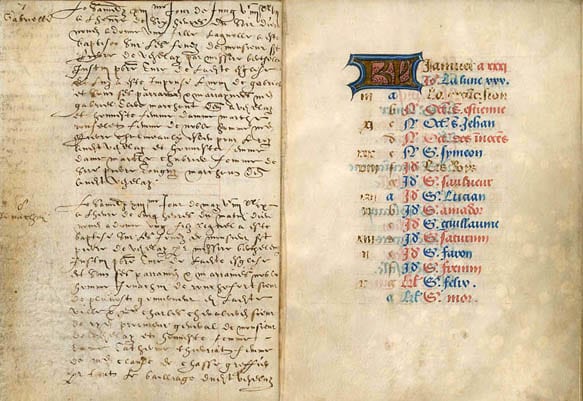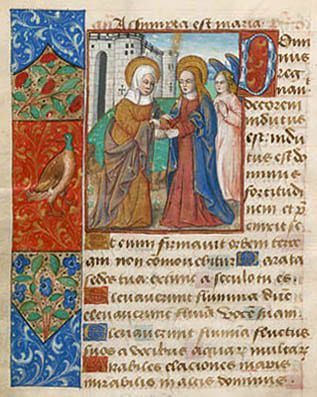Book of Hours, BX2080 .A2 1497, Special Collections
50 Features of Special Collections: The Most Popular Book

As a “bestseller of the Middle Ages,” the Book of Hours is a prayer book intended for use by ordinary people who are not part of the clergy. The Book allowed Catholics to follow and express their devotion to the Virgin Mary by setting aside certain times throughout the day to recite services. While the Book of Hours may vary from volume to volume, it usually consists of eight different sections: 1) a Calendar, 2) the Gospel Lessons, 3) the Hours of the Virgin, 4) the Hours of the Cross and the Hours of the Holy Spirit, 5) two prayers to the Virgin: Obsecro te (“I beseech thee”) and O intemerata (“O undefiled one”), 6) the Penitential Psalms and Litany, 7) the Office of the Dead, and 8) Suffrages.
The heart of the Book of Hours, originally named after the Hours of the Virgin or the Little Office of the Blessed Virgin Mary, consists of eight short services:

These services are actually shortened versions of much longer and more demanding services – the Divine Office – contained in the Breviary, which the clergy were required to recite daily. Both the Breviary and the Book of Hours include prayers, hymns, psalms, and scriptural text. As the language of scholarship during the Middle Ages and Renaissance, Books of Hours were typically in Latin; however, special prayers and entire Books could be found in the vernacular. For owners who were illiterate, many could recite most of the prayers in the Book of Hours by memory and use the pictures as reference points.
Since the Book of Hours was initially expensive to produce, it was often handed down and became part of family history. As examples of great works of art, the Books served as objects of religious devotion as well as status symbols. Depending on the wealth of the owners, the Book could include extravagant details such as illuminated initials, decorated borders, and miniature paintings dividing major sections of text, or remain plain with little to no decoration. In more luxurious Books of Hours, owners sometimes paid great amounts to include portraits of themselves or their family emblems in the illustrations. The process for creating a fancy Book of Hours follows:
The material used was vellum, calfskin or sheepskin which had been soaked in a caustic lime solution, scraped and shaved to an even thinness, rubbed smooth with pumice, stretched till dry, and then cut to size. A Book of Hours was prepared by a group of professionals, often in a single workshop under a master. First the text – lettered in uniform calligraphy – was written with a quill pen by a scribe. Then the ornamental borders of styled sprays and branches, of leaves and of flowers, were drawn by a specialist, using red and other colors. The pictures were then painted by another artist, usually the master, and they were sometimes major works of art within the small size of a miniature.


The use of gold was applied as gold leaf to decorate the frames of and objects in miniatures, leaves in borders, and to illuminate initials. The Book of Hours in Special Collections was acquired by UC Davis in 1972 at the 8th California Antiquarian Book Fair in San Francisco. In our Book of Hours, there are two miniatures illustrating the Office of the Dead: one shows a king lying in a freshly dug grave in a churchyard while Death, carrying a coffin, stabs his spear at one of the two mourners; the other features Heaven and Hell. Another miniature, the Visitation of the Virgin Mary to St. Anne, shows an angel attending to the Virgin, illustrating the hour of Lauds. We believe our Book was originally owned by Chachere who recorded the births of his 15 children between 1497 and 1520 on additional leaves at the end. For more information about the Book of Hours in Special Collections, please contact speccoll@ucdavis.edu. View our Book of Hours online at the Digital Scriptorium.


Works consulted:
Marmion, Simon. Book of Hours. San Marino, CA: Huntington Library, 2004.
Backhouse, Janet. Illumination from Books of Hours. London: British Library, 2004.
Backhouse, Janet. Books of Hours. London; Dover, NH: British Library, 1985.
Wieck, Roger S. Time Sanctified: the Book of Hours in Medieval Art and Life. New York: G. Braziller in association with the Walters Art Gallery, Baltimore, 1988.